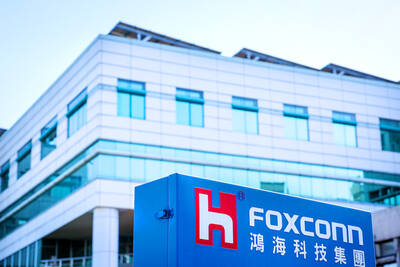The TAIEX yesterday closed lower after posting early gains because of mounting diplomatic tensions between the US and China, dealers said.
Selling was seen across the board except in the semiconductor sector, which managed to hold its own, led by the nation’s two top pure foundry plays, preventing the broader market from falling further, they said.
The TAIEX closed down 109 points, or 0.88 percent, at 12,304.04 on turnover of NT$264.547 billion (US$8.95 billion).

Photo: Wang Meng-lun, Taipei Times
The benchmark index opened up 0.44 percent and rose to the day’s high just before 10:30am on a technical rebound from a session earlier, when it closed down 0.48 percent, dealers said.
However, the upturn was ended by mounting US-China tensions, which pushed the index below the nearest technical support level ahead of the five-day moving average of 12,352.
Investors were reacting to Beijing ordering the US consulate in Chengdu to be closed in retaliation for the US ordering the closure of China’s consulate in Houston, Texas, on Wednesday.
“China’s retaliatory move complicated the political landscape between the two powers,” Concord Securities Co (康和證券) analyst Kerry Huang (黃志祺) said. “Many investors fear the Chinese yuan will weaken and send other regional currencies into a tailspin, leading to a fund outflow from the region.”
“Taiwan was not the only market to feel the pinch. Selling emerged across the region today,” Huang said, referring to the stock markets in Shanghai, Shenzhen, Hong Kong and Seoul.
In Taipei, many investors seized on the political unease as an excuse to lock in gains after the TAIEX closed at a 30-year high earlier this week.
“The silver lining was that the semiconductor sector served as an anchor to prevent further losses, led by contract chipmaker Taiwan Semiconductor Manufacturing Co [TSMC, 台積電] and its smaller rival United Microelectronics Corp [UMC, 聯電],” Huang said.
TSMC shares rose 1.18 percent to close at NT$386, off a high of NT$395, while UMC shares gained 2.6 percent to close at NT$19.75 after hitting a high of NT$20.30.
Chip designer MediaTek Inc (聯發科) lost 0.3 percent to close at NT$675, smartphone camera lens maker Largan Precision Co (大立光) dropped 1.94 percent to close at NT$3,800 and iPhone assembler Hon Hai Precision Industry Co (鴻海精密) shed 2.56 percent to close at NT$80.
Among falling old economy stocks, Far Eastern New Century Corp (遠東新世紀) lost 2.67 percent to close at NT$29.20, Formosa Chemicals & Fibre Corp (台灣化纖) fell 1.13 percent to close at NT$69.80 and Uni-President Enterprises Corp (統一企業) dropped 0.97 percent to close at NT$71.30.
In the financial sector, which ended down 1.16 percent, Fubon Financial Holding Co (富邦金控) lost 1.64 percent to close at NT$42 and Mega Financial Holding Co (兆豐金控) fell 1.68 percent to NT$32.15.
“Politics is dominating global markets, and if things get worse and hurt foreign institutional investor sentiment, further volatility is possible,” Huang said. “The TAIEX may not see strong technical support until 12,097, the 20-day moving average.”
Foreign institutional investors yesterday sold a net NT$10.83 billion of shares, Taiwan Stock Exchange data showed.

GREAT SUCCESS: Republican Senator Todd Young expressed surprise at Trump’s comments and said he expects the administration to keep the program running US lawmakers who helped secure billions of dollars in subsidies for domestic semiconductor manufacturing rejected US President Donald Trump’s call to revoke the 2022 CHIPS and Science Act, signaling that any repeal effort in the US Congress would fall short. US Senate Minority Leader Chuck Schumer, who negotiated the law, on Wednesday said that Trump’s demand would fail, while a top Republican proponent, US Senator Todd Young, expressed surprise at the president’s comments and said he expects the administration to keep the program running. The CHIPS Act is “essential for America leading the world in tech, leading the world in AI [artificial

DOMESTIC SUPPLY: The probe comes as Donald Trump has called for the repeal of the US$52.7 billion CHIPS and Science Act, which the US Congress passed in 2022 The Office of the US Trade Representative is to hold a hearing tomorrow into older Chinese-made “legacy” semiconductors that could heap more US tariffs on chips from China that power everyday goods from cars to washing machines to telecoms equipment. The probe, which began during former US president Joe Biden’s tenure in December last year, aims to protect US and other semiconductor producers from China’s massive state-driven buildup of domestic chip supply. A 50 percent US tariff on Chinese semiconductors began on Jan. 1. Legacy chips use older manufacturing processes introduced more than a decade ago and are often far simpler than

Hon Hai Precision Industry Co (鴻海精密) yesterday said that its research institute has launched its first advanced artificial intelligence (AI) large language model (LLM) using traditional Chinese, with technology assistance from Nvidia Corp. Hon Hai, also known as Foxconn Technology Group (富士康科技集團), said the LLM, FoxBrain, is expected to improve its data analysis capabilities for smart manufacturing, and electric vehicle and smart city development. An LLM is a type of AI trained on vast amounts of text data and uses deep learning techniques, particularly neural networks, to process and generate language. They are essential for building and improving AI-powered servers. Nvidia provided assistance

Gasoline and diesel prices this week are to decrease NT$0.5 and NT$1 per liter respectively as international crude prices continued to fall last week, CPC Corp, Taiwan (CPC, 台灣中油) and Formosa Petrochemical Corp (台塑石化) said yesterday. Effective today, gasoline prices at CPC and Formosa stations are to decrease to NT$29.2, NT$30.7 and NT$32.7 per liter for 92, 95 and 98-octane unleaded gasoline respectively, while premium diesel is to cost NT$27.9 per liter at CPC stations and NT$27.7 at Formosa pumps, the companies said in separate statements. Global crude oil prices dropped last week after the eight OPEC+ members said they would